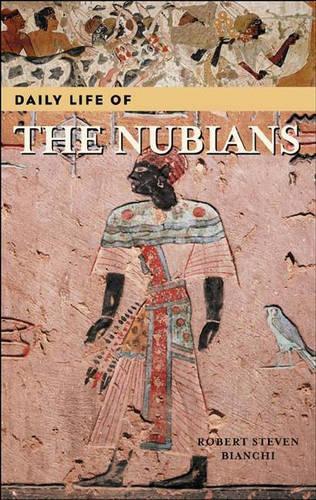
Daily Life of the Nubians
(Hardback)
Publishing Details
Daily Life of the Nubians
By (Author) Robert Steven Bianchi
Bloomsbury Publishing PLC
Greenwood Press
30th October 2004
United States
Classifications
General
Non Fiction
Ancient history
Social and cultural history
939.78
Physical Properties
Hardback
312
Width 156mm, Height 235mm
624g
Description
Until recently little was known about ancient Nubia and the day-to-day lives of the Nubian people aside from knowing it was a civilization contemporary with, distinct from, and living under the shadow of Ancient Egypt. Nubia existed from about 3500 - 300 BC, close to three thousand years. Thanks to recent massive archaeological surveys we now have a much clearer picture of Nubian civilization, what they ate, how they dressed, how they cared for their dead, their military triumphs and defeats, where their cities were built, and what they looked like. Of course they underwent dramatic changes over time, and these are noted where appropriate. Though often confused with the Ethiopians of Greek lore, little doubt remains that Nubians were in fact Black African peoples, and their civilization has been claimed by many as proof of a sophisticated and ancient Black African society. For ease of use by students, the work is organized chronologically. Each chapter is divided into convenient subheadings that detail military matters and warfare, government, language, relations with neighbouring civilizations, work and the economy, engineering and architecture, housing, transportation, family life, life cycle events, women's roles, art, music and dance, literature, science, and religion. It includes an historical timeline of Nubian history, a glossary of Nubian terms, and a bibliography for further reading. Throughout the work, Bianchi, an expert on the Nubians, shows how the modern world has little by little come to discover and recognize the distinctiveness and importance of Nubia in ancient history. This work will replace all earlier resources on Nubian life and will provide school and public librarians with the most up-to-date and historically correct information on the Nubians.
Reviews
"In this unique, well-written handbook, Bianchi provides an account of ancient Nubian culture that will be of value primarily to undergraduate students of ancient history, art history, and Egyptology....[w]ill serve quite well as a reference source for undergraduates and the general public. Recommended. All levels and libraries."-Choice
[P]rovides middle and high school students with the most up-to-date, historically accurate information about ancient Nubia and the day-to-day lives of the Nubians.-Multicultural Review
[R]eflecting recent archaeological discoveries which fill in many gaps in the history of ancient Nubian life. Any library with a history of Nubian culture will find this essential.-MBR Bookwatch/Donovan's Bookshelf
In this unique, well-written handbook, Bianchi provides an account of ancient Nubian culture that will be of value primarily to undergraduate students of ancient history, art history, and Egyptology....[w]ill serve quite well as a reference source for undergraduates and the general public. Recommended. All levels and libraries.-Choice
"Provides middle and high school students with the most up-to-date, historically accurate information about ancient Nubia and the day-to-day lives of the Nubians."-Multicultural Review
"Reflecting recent archaeological discoveries which fill in many gaps in the history of ancient Nubian life. Any library with a history of Nubian culture will find this essential."-MBR Bookwatch/Donovan's Bookshelf
"[P]rovides middle and high school students with the most up-to-date, historically accurate information about ancient Nubia and the day-to-day lives of the Nubians."-Multicultural Review
"[R]eflecting recent archaeological discoveries which fill in many gaps in the history of ancient Nubian life. Any library with a history of Nubian culture will find this essential."-MBR Bookwatch/Donovan's Bookshelf
Author Bio
Robert S. Bianchi served as curator in the Department of Egyptian, Classical, and Ancient Middle Eastern Art at the Brooklyn Museum of Art. He has written several articles about Nubian art in general and one young reader's book on the subject, The Nubians: People of the Ancient Nile (1994).
